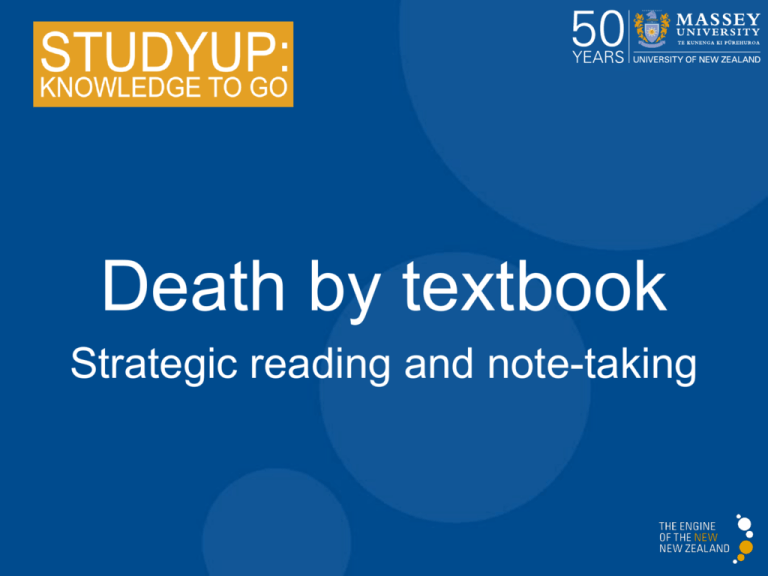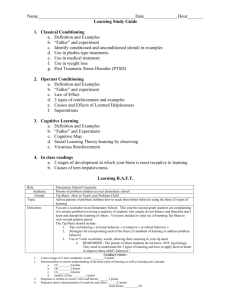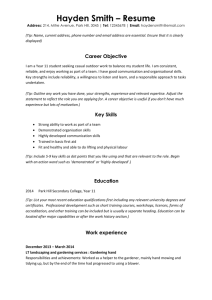View Slides
advertisement

Death by textbook Strategic reading and note-taking Learning outcomes By the end of this workshop, you should have a better idea how to: • Stay awake while reading… • Know what to read • Know how much to read • Keep track of the information you’ve read (take notes) True or false? 1. You need to read most of what’s on your reading list, starting at the top and working your way down. 2. All books and articles are well written and truthful. 3. You can’t really disagree with an academic text, because you’re not an expert. 4. Intelligent people only need to read things once. Stay awake – active reading I pick up my textbook, but find myself daydreaming about what to have for dinner, or the tv show I watched last night… Reading for study requires not just your eyes, it requires active effort that engages your brain. Try active reading: techniques to help you concentrate and stay focused. Stay awake – active reading Active reading techniques: Have a clear purpose – Why are you reading the article? What do you hope to get from it? Make predictions – What do you expect to find, what do you think they’ll say? Link back to what you already know – How does it relate to other topics and your life experience Challenge the author – Who are they? Why have they written the article? Take notes Active reading takes practice TOP TIPS Top tip#1: Sometimes new information doesn’t make sense at first, understand that it takes time to learn new topics. Top tip#2: Try writing your own glossary of new terms. Top tip #3: If a text is really difficult to follow, put it down and read something else on the topic. How do you know what to read? • Weekly study: See Stream: read what you have to read (text book chapters for that week, selected readings) • For assignments: Start with relevant sections of the text book and look at your suggested readings list (if you have one) Take control of your reading list • Understand your lecturers’ expectations: – Sometimes they set out the expected readings for each week – Sometimes they provide you will core and suggested readings, but DON’T want or expect you to read everything on the list • Start with the minimum, then think about: – How much time you have – Is an assignment due in a few weeks – Do you feel you need to clarify some ideas or learn more about a topic Take control of your reading Reading for assignments • If reading for an assignment, understand the instructions (or question). – What is the topic? What is the scope? What are you being asked to write about? – Use the essay question to guide your selection of articles. Essay question: To what extent is there a correlation between the levels of happiness experienced by cats, and the dog being made to sleep outside. Possible articles from your reading list Which ones are relevant? Gibney, J., & Vorster, H. (2002). The psychology of cats and dogs: An introduction. London, England: Blackwell. Whitney, J. (2004). Levels of happiness in cats. The International Journal of Pet Psychology, 1, 22-45. McArdle, J., & Katch, M. (1998). The history of domestic pets in Samoa. London, England: Penguin. If searching for extra sources Which one/s would you use? Graham, C. (2005, January 12). Why cats and dogs fight. Australian Women’s Weekly, 21(1), 21-24. Dog-cat relationship. (2012). Retrieved from http://en.wikipedia.org/wiki/Relationships_between_cats_an d_dogs Frey, T., & James, B. (2009). Addressing levels of happiness and aggression in felines and canines. Journal of Feline and Canine Medicine and Surgery, 7(29), 1-2. Dog, G. (2004). Why cats should be eliminated from the planet. Retrieved from http://www.dogpreservationsociety.org/ Sources checklist When deciding whether to use an article/book for your assignment, go through this checklist: 1. What type of source is it? (book, journal article, information from a website etc) 2. Who wrote it and when? 3. Is it relevant, reliable and academic? (if not, is that ok?) 4. Why are you going to read it (what do you want to get out of it?) - a definition background information is some relevant for your argument? is it a major and substantial theorist/topic for your assignment/paper TOP TIPS Top tip#4: Reading lists are not usually formatted using the correct referencing style you will need to use. Top tip#5: Check the reference list in your text book and suggested readings for ideas on other articles on the topic. Top tip#6: If searching for your own articles, start by searching the “Discover” database. Top tip#7: Check out the library’s online classes (see the link on the StudyUp registration page). How do you know how much to read? Remind yourself: • Why are you reading this article? Ask yourself: • How does it relate to your assignment? – Does all of it relate, or just some of it? • Do you need to scan it quickly, or read it thoroughly? How do you know how much to read? How do you read a novel? What are the differences between reading a novel and a text book? – don’t read a textbook or journal article from start to finish – don’t pick up academic texts and start reading them in-depth – A novel uses one reading technique – different reading techniques are needed for reading academic texts. Three different ways to read: 1. Scanning 2. Gist reading (or skimming) 3. Close reading (in-depth reading) Scanning Looking over material quickly in order to pick out specific information. Why scan information? • Useful when: – Browsing a database for texts – Scanning a text for specific information – Looking back over material Gist reading Reading something quickly to get the general idea or feel. • You can read for gist by reading the headings, introduction and conclusion. • Or you can go over the whole article very quickly - first sentence in paragraph, gloss over bit. Why read for gist? • Useful for: – Deciding whether to reject a text or – Deciding whether to read in more detail Close reading Reading something in detail. • Why give read an article in-depth? – To clearly understand the topic – Research detailed information for an assignment – Read difficult sections of a text You will need to do a lot of close reading for academic study. Keep track of the information you’ve read - Taking notes • Helps you remember • Helps you learn • Helps you stay awake while reading! Have a clear purpose • Why are you reading the article? • What sort of information should you note down? – All the essential points and arguments? – Only information on a specific theme? TOP TIPS Top tip#8: When taking notes, include full reference details of the article/book you’re reading – prevents the stress of wanting to use information in an assignment and not remembering where it came from! Top tip#9: Write the page number down every time you’re taking notes from a different page (means you can locate the original information if you need to double check anything). TOP TIPS Top tip#10: When copying direct quotes consider making them stand out in your notes – use a different colour, a highlighter, or obvious quotation marks. Top tip#11: Avoid “highlighter syndrome” (when you highlight everything on the page) by reading first, getting a sense of what is relevant, then taking notes. Note-taking • There are different ways of taking notes • You may like to experiment with different note formats • Some examples: – Mind maps – Linear notes/summaries – Charts Great resources for note-taking are available online, see OWLL for details Mind map Therapeutic Management & Complications Pain Management 1. Paracetamol 2. Oral Morphine M-ESLON SEVREDOL 3. Codine Infection 1. Antibiotics ULCERS Clinical Features Clinical Manifestations (symptoms) • Redness •Oedema •Tenderness •Actual visable ulcer • Broken skin area (ROTAB) Causes Nursing Considerations Assessment • • • Action • • •Bed bound for long periods •Not turning patients •Diabetes •Vascular issues Mind map From the Mind Tools website: http://www.mindtools.com/media/Diagrams/mindmap.jpg Outline Summary/linear notes 172.237 A Global Perspective on English – Topic 3 Global Varieties of Eng. Lang. Kachru & Nelson (2001 pp. 14-15) Inner Circle USA, UK, Canada, NZ, Aus - last 3 controversial p. 10 All public functions > Eng. •gov; media, creative pursuits; edu. Outer Circle India, Pakistan, Nigeria, Singapore, South Africa, Zambia + others •See table Kachru & Nelson (2001, p. 11) for more egs of outer and inner countries Long history as institutionalized lang. & has cultural role too •gov/edu. •Literary creativity / pop cul. Summary notes This version of summary or linear notes adds a summary of the main argument, plus own thoughts about the material. Notes like this are a great way to start thinking critically about a topic. Charts Especially good for planning compare and contrast questions 3 basic issues Piaget Vygotsky Continuous or discontinuous development? Discontinuous – stages of development Continuous – gradually acquire skills One course of development or many? One – stages are universal Many possible courses Nature or nurture most important? Both nature and nurture Both nature and nurture Example of a Study Matrix Displays the similarities and differences Group Name Archybacteria Methanoger Halophile Thermacidophile Bacteria Janobacteria Notorophic Pseudonomads Spriochaetes Endosphere Formers Reproduction RNA O2 Relation Ob. Anaero Habitat Swamp/ marsh endobiotic Morphology Solitary Covering Unique Membrane Lack paptidoglycin Get Energy H2 + CO2 CH4 + H2O Host Relation Few(-) & many(+)





